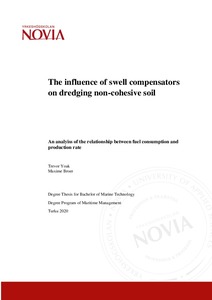The influence of swell compensators on dredging non-cohesive soil
Yoak, Trevor; Broer, Maxime (2020)
Yoak, Trevor
Broer, Maxime
2020
All rights reserved. This publication is copyrighted. You may download, display and print it for Your own personal use. Commercial use is prohibited.
Julkaisun pysyvä osoite on
https://urn.fi/URN:NBN:fi:amk-2020111823199
https://urn.fi/URN:NBN:fi:amk-2020111823199
Tiivistelmä
Dredging companies constantly need to assess their technical procedures to ensure the highest levels of efficiency resulting in happier customers, better profit margins and a healthier environment. The complicated nature of dredging with a Trailing Suction Hopper Dredger – influenced by environmental forces, soil mechanics, and onboard machinery functionality – tends to obfuscate points of optimization. This study eliminates many of those outside influences, via the use of a dredging simulator, in order to investigate the effect of the swell compensator on the relationship between fuel consumption and soil production.
Armed with mainly theoretical information on the swell compensator’s effect, this research tested the theories through controlled experiments where the simulated dredging vessel conducted operations on different types of non-cohesive soil at 25 meters depth. The analysis found 20 bar of pressure in the swell compensator resulted in the lowest fuel consumption and highest soil production rate. The research also showed minimal deviation when altering soil granularity and water depth. Given the nature of controlled environments, this result can only be used as guidance for real vessels. However, it represents a starting point applicable to a wider range of ships that can go on to observe their own trends. Further research to improve the simulator is required to hone the results and make them more comparable to real life conditions.
Armed with mainly theoretical information on the swell compensator’s effect, this research tested the theories through controlled experiments where the simulated dredging vessel conducted operations on different types of non-cohesive soil at 25 meters depth. The analysis found 20 bar of pressure in the swell compensator resulted in the lowest fuel consumption and highest soil production rate. The research also showed minimal deviation when altering soil granularity and water depth. Given the nature of controlled environments, this result can only be used as guidance for real vessels. However, it represents a starting point applicable to a wider range of ships that can go on to observe their own trends. Further research to improve the simulator is required to hone the results and make them more comparable to real life conditions.
